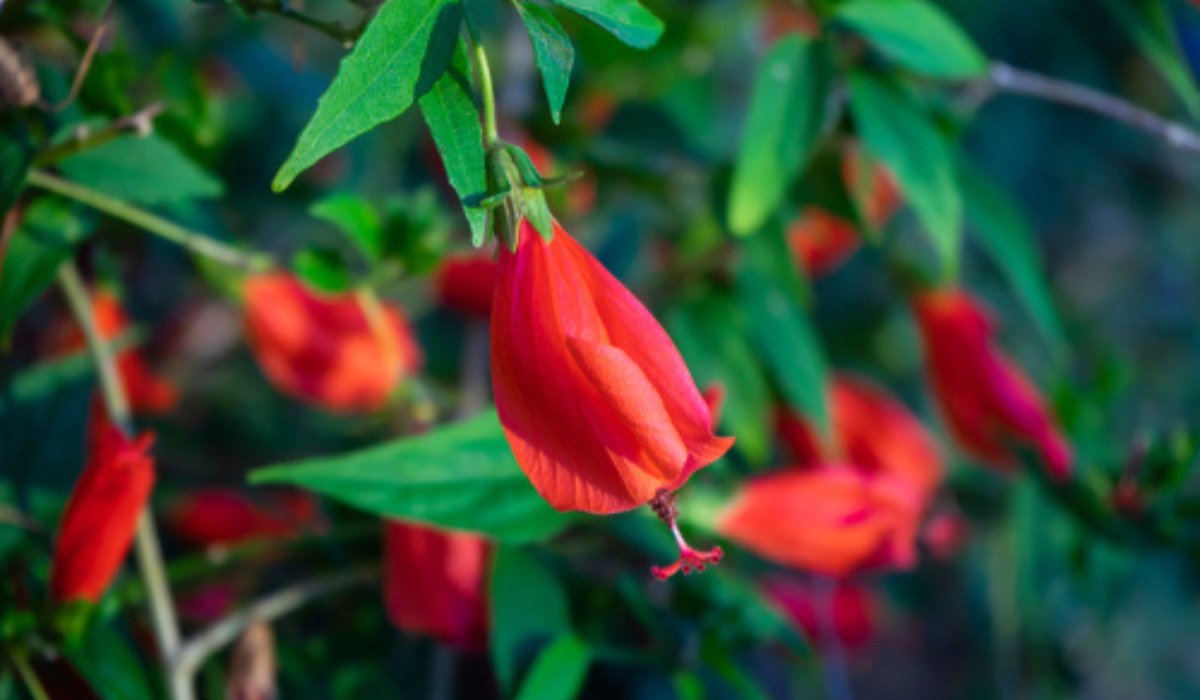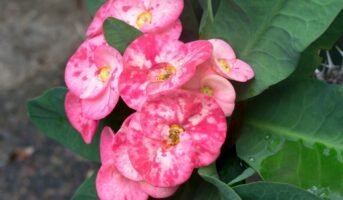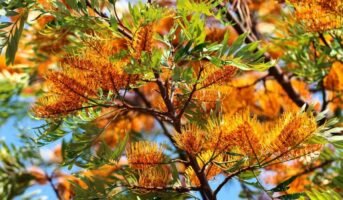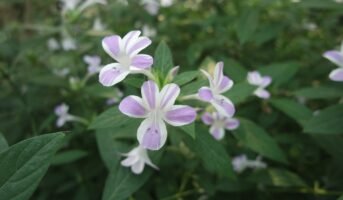Malvaviscus arboreus belongs to a species of flowering plant belonging to the Malvaceae family of hibiscus. It is native to Mexico, Central America and the Gulf Coast of the United States, where it is commonly an understory shrub in coastal Texas and Louisiana.
Arboreus, the scientific name, alludes to its tree-like appearance. It is now widely cultivated and known by a variety of English names, including wax mallow, red mallow, Texas mellow, Turk’s hat (mallow), Turk’s turban, sleeping hibiscus, firecracker hibiscus, old man’s apple, white moho, wild apple, Mexican apple, bleeding hearts, and manzanita, among others.
The plant is renowned for its ability to withstand both scorching summers and chilly winters because it can withstand temperatures well below zero.
See also: Tips to grow and take care of anthurium
Malvaviscus arboreus: Key facts
| Name | Malvaviscus arboreus |
| Family | Malvaceae |
| Native | Central America, Mexico, and the Gulf Coast of the United States, coastal Texas and Louisiana |
| Other Names | Wax mallow, Turk’s cap (mallow), ladies teardrop, Turk’s turban, sleeping hibiscus |
| Life cycle | Perennial |
| Habit | Shrub |
| Leaf colour | Light to medium green |
| Flower colour | White, red |
| Bloom time | May, Jun, Jul, Aug, Sep, Oct, Nov |
| Fruit | yes |
| Size | 3-6 ft |
| Water Requirement | Medium |
| Light Requirement | Part shade, shade |
| Soil | Dry, moist |
| Soil Description | Sandy, loamy, clay, and limestone soil, moist, well-drained, woodland soil |
| Feature | Drought tolerant |
| Maintenance | Low |
Malvaviscus arboreus: Description
Due to the way its unopened flowers resemble Hibiscus flowers, it was given this name and is primarily planted for the same reason. Butterflies and hummingbirds are attracted to it by the partially opened blossoms. This spreading shrub typically grows to a height of 4 feet (1 m), but with an equal spread, it has the potential to reach a height of 10 feet (3 m). Near the plant’s base, the wax mallow’s stems are woody, but as they approach the branch tips, they become fuzzier and greener. The plant’s leaves can grow up to 5 inches (13 cm). In the summer, flowers with a length of about 2 inches (5 cm) bloom, luring hummingbirds, butterflies, and bees. Small, red fruit the size of marbles that are frequently consumed by wildlife follow them. The fruit can be eaten by people both raw and cooked.

Source: Pinterest
Malvaviscus arboreus: How to grow
If you’re curious about how to develop a wax mallow plant, you’ll discover that it isn’t extremely challenging.
- These plants can grow by softwood cuttings, seeds, and root division. Select the method that best fits your degree of gardening expertise and the available resources.
- Turk’s cap can be grown in a container as well. To support such a massive plant, make sure the container is deep enough and wide enough.
- In addition, it can thrive in poor soil, during dry periods, or when exposed to heavy downpours.
- Fresh, untreated seeds sown outside after the danger of frost has passed will quickly sprout into plants. Don’t cover the seeds more than 1/4 to 1/2 inch deep.
- The cuttings need to be 4 to 6 inches long, with the bottom leaves removed, and should be treated with rooting hormone before applying it to the ground. Transplant the new, smaller plants into a growth area with well-draining soil and the right amount of sunlight. Make sure to water the plants thoroughly to help them build new root systems.
- Turk’s cap typically blooms between May and November or up until the first frost in your region. The plant will produce more flowers when exposed to more sunlight.

Source: Pinterest
Malvaviscus arboreus: Maintenance tips
You’ll discover that caring for wax mallow plants is pretty easy and won’t require much of your time.
- Caring for this plant will become easier if you grow the shrub in damp, well-drained woodland soils.
- Watering Turk’s cap should be your first step in growing it. This plant can tolerate dry seasons. However, supplying steady water can support good blooming. It is, therefore, preferable to water this plant deeply and for an extended period.
- When applying water, make sure that it soaks into the plant’s roots and then drains away. It should also completely cover the area around the plant.
- Whenever you add more water, always test the soil first. Take a finger and dunk it into the soil next to the plant. When it’s completely dry up to your first knuckle, you should water deeply again. To help the plant in retaining moisture for a longer period, you might also think about mulching the area around it.
- Lastly, you should prune Turk’s cap. This is mainly to keep the plant at the desired size for the area it’s planted.
- The next step is to apply a balanced fertiliser once a month throughout the blooming season, which in turn helps the plant to bloom.
- Turk’s cap is not very susceptible to garden pests and illnesses. Mealybugs, spider mites, and white flies are the main pests this plant has to deal with. To stop these pests from causing too much harm to your plant, you should treat them all with an insecticide as soon as you notice them.
- Moisture might become trapped when there is insufficient ventilation around the plant. Fungal problems result from this. So, prevent water logging.
Malvaviscus arboreus: Uses
Medicinal uses
- It contributes to the overall improvement of the cardiovascular system’s health. It also benefits the immune system as a whole.
- Wax mallow flowers are used to regulate blood sugar in several traditional cultures.
- Emollients made from the plant’s leaves have been used to alleviate inflammation, relieve itching, and soften skin.
- In rare situations, the herb may even assist in encouraging hair growth by slowing down balding.
- The plant’s flowers were utilised by Mexicans as a menstrual aid and to cure gastrointestinal discomfort.
- The plant has been used to treat a variety of illnesses, including bronchitis, cystitis, diarrhoea, dysentery, fever, cough, common cold, and flu, as well as gastritis, hypertension, kidney diseases, liver and gallbladder issues, gallstones, diabetes, stomach aches, sore throats, tonsillitis, and wounds.
Culinary uses
- The plant is used in salads, herbal teas, and herbal dyes. A red dye is produced by it.
- The flowers can be used to brew tea, whether they are fresh or dried.
- The blooms are consumed in Thailand as a salad or in light curries.
- A pink lemonade-like beverage can be made with flowers.
- Young, fragile leaves can be cooked to soften their texture and utilised like spinach. These leaves can be cooked well by steaming, sautéing, boiling, or stir-frying.
- The berries can also be dried and converted into wine, jam, or jelly. Turk’s Cap also has a small, edible red fruit that resembles an apple, giving rise to the plant’s alternate name, the Mexican apple.
Other uses
- The plant is utilised as a potted indoor plant as well as a landscape and garden plant, particularly in shady areas.
- You can utilise bark, both inner and outer parts, to make good cordage.
- The stems’ fibre can be woven into burlap-like fabrics or used to manufacture rope.

Source: Pinterest
Malvaviscus arboreus: Is it toxic?
No toxic nature of this plant has been registered.
FAQs
Does Malvaviscus arboreus require low maintenance?
Yes! Malvaviscus arboreus is a low-maintenance plant and can thrive easily when kept under favourable conditions.
How often should I add fertiliser to this plant?
Apply a balanced fertiliser once a month throughout the blooming season, which in turn helps the plant to bloom.
Housing News Desk is the news desk of leading online real estate portal, Housing.com. Housing News Desk focuses on a variety of topics such as real estate laws, taxes, current news, property trends, home loans, rentals, décor, green homes, home improvement, etc. The main objective of the news desk, is to cover the real estate sector from the perspective of providing information that is useful to the end-user.
Facebook: https://www.facebook.com/housing.com/
Twitter: https://twitter.com/Housing
Email: [email protected]











